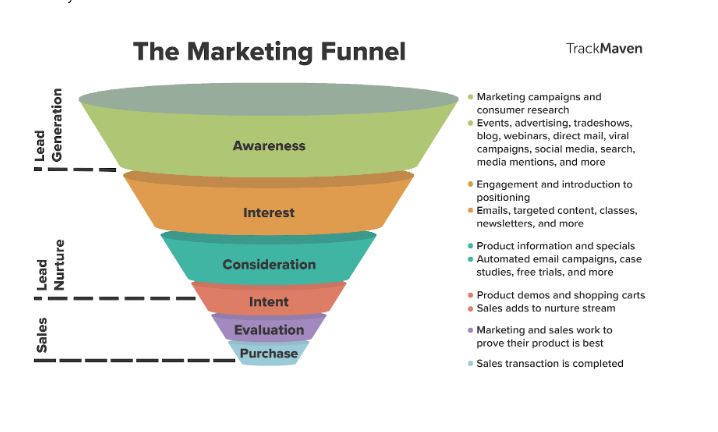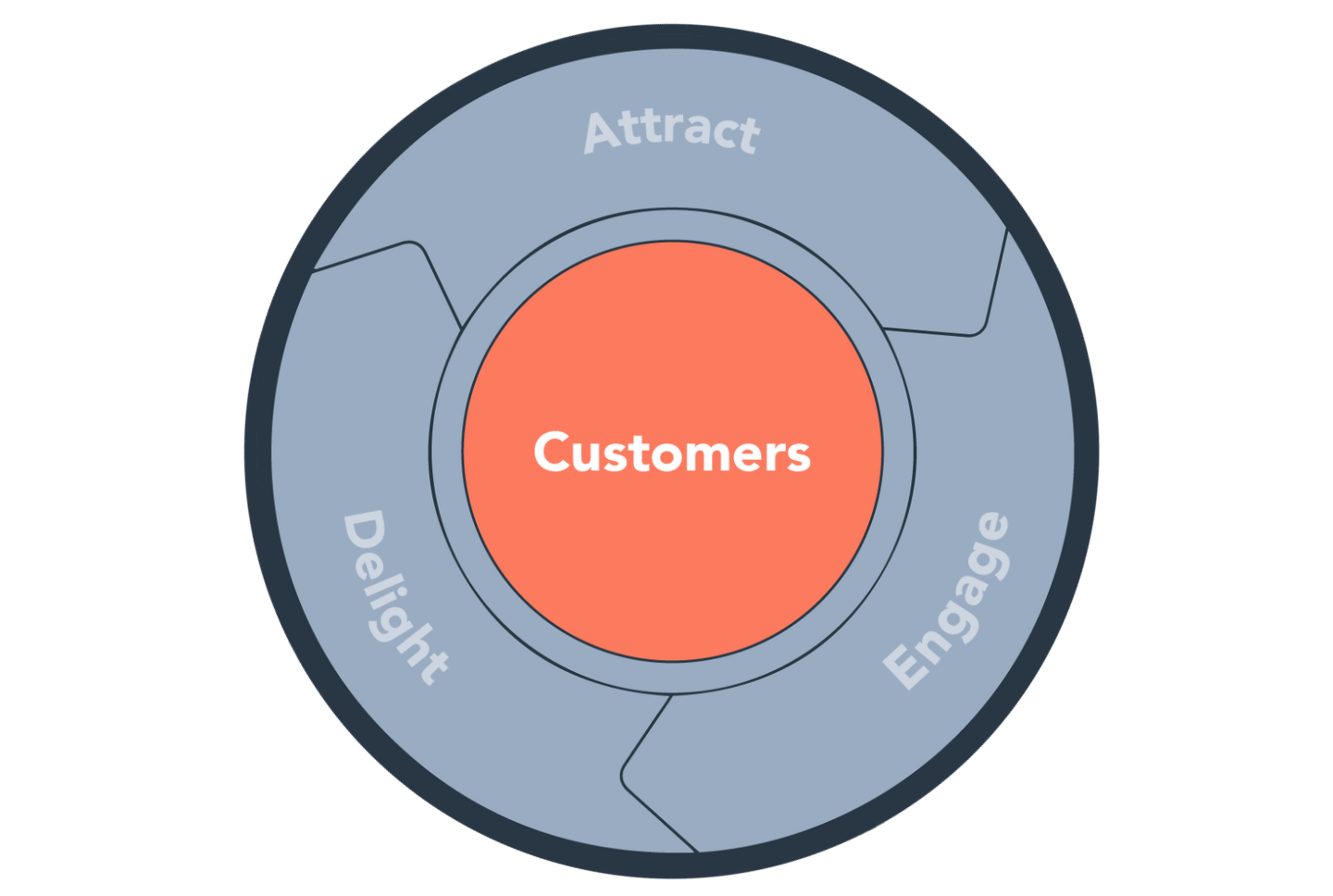Most software-as-a-service (SaaS) companies implement customer success programs to reduce churn. But there’s a reason that McKinsey calls customer success “ the new growth engine.”
Companies are starting to integrate customer success and marketing efforts to drive full-funnel growth.
It might seem like a strange partnership. Marketing efforts are directed at pre-sale prospects. Customer success is focused on ensuring that current customers are getting the results they want after the sale.
But pairing the two generates powerful results.
Keep reading to find out why marketing’s new conception of the customer lifecycle requires customer success, and how CSMs and marketers can help each other create a great customer experience.
The Customer Lifecycle Is Changing
The most familiar model of the customer lifecycle (at least in marketing) is the funnel. It usually looks like this:

[Caption] This is how TrackMaven explains the funnel. There are other representations too, but this is representative of most of them.
If you’re familiar with the funnel, you probably know that it’s been receiving pushback lately. People have reconceptualized the customer lifecycle in all sorts of ways. One of the best examples is Hubspot’s customer flywheel:

[Caption] HubSpot has replaced their funnel with the flywheel.
New visions of the lifecycle emphasize that marketing doesn’t end at the sale. Instead, it aims to create engaged customers that attract more customers. And the cycle continues.
To engage and delight customers, you’ll need a combination of things:
- A great product
- Content that drives engagement
- A sales team that understands what prospects are looking for
- A strong focus on customer success
- Responsive customer support
Together, these factors attract and retain customers.
In this model, marketing, sales, customer success, tech support, and other departments work together to create the best possible customer experience.
There are other models of the customer lifecycle. But the flywheel shows the importance of creating a great customer experience through post-sale interactions.
Let’s take a look at some of the ways customer success managers and marketing departments can work together to create that customer experience.
Setting And Delivering Great Expectations
Marketing creates a set of expectations for potential customers. What will they get from the product or service? How will it improve their lives? What kind of return-on-investment will they get?
Marketing tells prospects that they can expect big things when they become customers. But it’s up to customer success managers to make good on those promises.
And that means the two need to work together. If your customer success team can’t deliver on the promises your marketers are making, you’ll disappoint customers. That’s bad for business.
On the other hand, customer success agents can let your marketing team know if they can promise better returns
For example, let’s say your app saves people time by automating email management.
Your marketing team wants to stay on the safe side and say that the average person saves two hours every week with the app. If your customer success team works with someone who saves five hours every week, that’s worth pointing out in your marketing campaign.
The two teams should be in constant communication. CSMs need to know what marketing initiatives are promising to customers. And marketers need to know what customers are actually achieving. A clear marketing metrics template will help keep both teams aligned.
Sharing customer achievements makes for a great content generation process, too. We’ll discuss that in a moment.
Great Customer Success Creates Brand Evangelists
Brand evangelists and word-of-mouth marketing are the holy grail of marketing efforts.
It’s difficult for your marketing team to create those things on its own, though. Largely because they don’t have much control over what happens post-sale.
But customer success teams do influence what happens after the sale. And if they do their job well, they’ll create the most valuable marketing assets in existence: delighted customers.
If you look at the Forbes Agency Council’s list of strategies to create brand advocates, you’ll see many strategies that focus on customer success:
- Provide top-notch satisfaction
- Create value for clients
- Be a “go-giver”
- Educate customers
- Listen and adapt to client needs
These are all things that CSMs do on a daily basis.
But happy customers still need to be encouraged to share their stories and tell their contacts about your company. Which means your CSMs need to have a marketing mindset when working with users and marketing partners.
Fortunately, their close relationships with your customers give them great insight into when they should ask for testimonials, encourage rating and reviewing your app, or referring other customers.
Customer Success Is A Good Source Of Success Stories
Case studies and success stories are valuable marketing materials. They still outperform most other types of marketing in reader completion, showing that readers find them to be very valuable.
There’s no better place to find stories of your customers doing great things than your customer success managers. They know your customers better than anyone else, and they see when your product or service has made a difference.
The key here is to maintain an open channel of communication between the two groups. Let CSMs know that they should tell marketing when a customer has a great story to share. And when marketers need a case study, they should know to go to your CSMs.
It might not even be for a long case study—it could be a regular social media post that highlights one customer doing cool things with your product.
This is also true of other teams. Your product team, for example, wants to know when someone has done something innovative with your product. If you sell accounting software and someone found a way to use it as an event planner, that’s worth looking into.
The same goes for sales—the more information they have about how customers find success with your product, the better.
The new customer lifecycle requires cooperation between many departments. Don’t pigeonhole your CSMs by only putting them in contact with customer support and account management.
Emphasize the value of cross-departmental collaboration, and provide the tools to make it happen.
Customer Support Needs Enablement, Too
Sales enablement is a process that connects sales and marketing to get salespeople the content they need to better serve clients.
This often means alerting the sales team when new blog posts are published. Or using the design crew to create a new one-pager that the sales team can send to prospects. There are all sorts of ways your marketers can help salespeople do their jobs.
But this process applies to customer success, too. Your marketing team can help your CSMs do their jobs by providing useful content to pass on to customers.
A proactive CSM, for example, will let a client know when the company publishes a blog post related to the client’s industry. The marketing team can facilitate this process by making it easy to track new posts. They might even tag them by industry in an internal database to make the process easier.
Or a CSM might decide that they need a brochure to help convince current clients that upgrading or buying a related product is a good idea. They should be able to go to marketing and request that. And, importantly, receive it quickly.
Because customer success is also providing marketing with great resources for their work in the form of customer success stories, this is an equal exchange where both teams benefit.
Traditional Roles May No Longer Apply
Customer experience is the key to growth and success.
To create a better customer experience, traditional business roles are changing. Marketing and sales are aligned more closely than ever before. Customer success managers cooperate with employees across the company.
Instead of siloed departments, companies now put an integrated, aligned team on the field in order to best solve problems as they arise. That creates a great customer experience and, eventually, brand evangelists.
If your customer success and marketing teams work together, they’ll not only move customers through the funnel faster—they’ll keep the flywheel turning.
Are your customer success and marketing teams aligned? If not, take action today: schedule a meeting with the leaders of both teams to talk about how they can start working together. Then take action.




